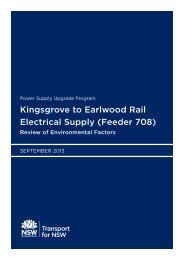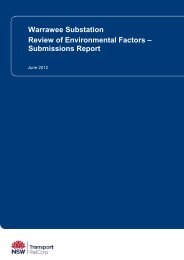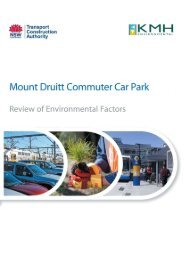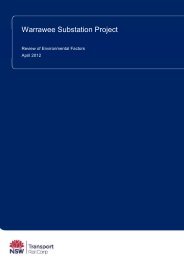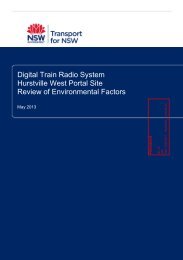Review of Environmental Factors - Transport for NSW - NSW ...
Review of Environmental Factors - Transport for NSW - NSW ...
Review of Environmental Factors - Transport for NSW - NSW ...
- No tags were found...
You also want an ePaper? Increase the reach of your titles
YUMPU automatically turns print PDFs into web optimized ePapers that Google loves.
For threatened ecological communities where the distribution is well known, maps are derived fromrecovery plans, State vegetation maps, remote sensing imagery and other sources. Where threatenedecological community distributions are less well known, existing vegetation maps and point location dataare used to produce indicative distribution maps.For species where the distributions are well known, maps are digitised from sources such as recoveryplans and detailed habitat studies. Where appropriate, core breeding, <strong>for</strong>aging and roosting areas areindicated under 'type <strong>of</strong> presence'. For species whose distributions are less well known, point locations arecollated from government wildlife authorities, museums, and non-government organisations; bioclimaticdistribution models are generated and these validated by experts. In some cases, the distribution maps arebased solely on expert knowledge.Only selected species covered by the following provisions <strong>of</strong> the EPBC Act have been mapped:- migratory and- marineThe following species and ecological communities have not been mapped and do not appear in reportsproduced from this database:- threatened species listed as extinct or considered as vagrants- some species and ecological communities that have only recently been listed- some terrestrial species that overfly the Commonwealth marine area- migratory species that are very widespread, vagrant, or only occur in small numbers.The following groups have been mapped, but may not cover the complete distribution <strong>of</strong> the species:- non-threatened seabirds which have only been mapped <strong>for</strong> recorded breeding sites;- seals which have only been mapped <strong>for</strong> breeding sites near the Australian continent.Such breeding sites may be important <strong>for</strong> the protection <strong>of</strong> the Commonwealth Marine environment.AcknowledgementsThis database has been compiled from a range <strong>of</strong> data sources. The department acknowledges thefollowing custodians who have contributed valuable data and advice:-Department <strong>of</strong> Environment, Climate Change and Water, New South Wales-Department <strong>of</strong> Sustainability and Environment, Victoria-Department <strong>of</strong> Primary Industries, Parks, Water and Environment, Tasmania-Department <strong>of</strong> Environment and Natural Resources, South Australia-Parks and Wildlife Service NT, NT Dept <strong>of</strong> Natural Resources, Environment and the Arts-<strong>Environmental</strong> and Resource Management, Queensland-Department <strong>of</strong> Environment and Conservation, Western Australia-Department <strong>of</strong> the Environment, Climate Change, Energy and Water-Birds Australia-Australian Bird and Bat Banding Scheme-Australian National Wildlife Collection-Natural history museums <strong>of</strong> Australia-Museum Victoria-Australian Museum-SA Museum-Queensland Museum-Online Zoological Collections <strong>of</strong> Australian Museums-Queensland Herbarium-National Herbarium <strong>of</strong> <strong>NSW</strong>-Royal Botanic Gardens and National Herbarium <strong>of</strong> Victoria



